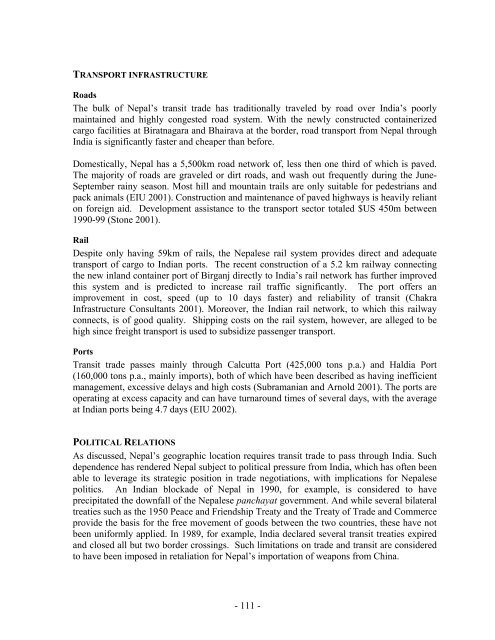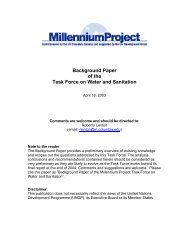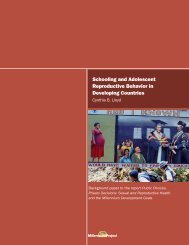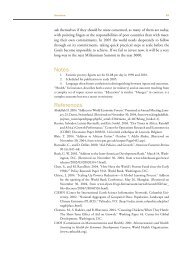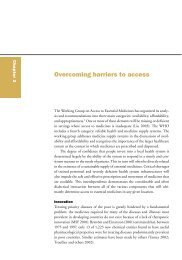the challenges facing landlocked developing countries: a case study ...
the challenges facing landlocked developing countries: a case study ...
the challenges facing landlocked developing countries: a case study ...
You also want an ePaper? Increase the reach of your titles
YUMPU automatically turns print PDFs into web optimized ePapers that Google loves.
TRANSPORT INFRASTRUCTURE<br />
Roads<br />
The bulk of Nepal’s transit trade has traditionally traveled by road over India’s poorly<br />
maintained and highly congested road system. With <strong>the</strong> newly constructed containerized<br />
cargo facilities at Biratnagara and Bhairava at <strong>the</strong> border, road transport from Nepal through<br />
India is significantly faster and cheaper than before.<br />
Domestically, Nepal has a 5,500km road network of, less <strong>the</strong>n one third of which is paved.<br />
The majority of roads are graveled or dirt roads, and wash out frequently during <strong>the</strong> June-<br />
September rainy season. Most hill and mountain trails are only suitable for pedestrians and<br />
pack animals (EIU 2001). Construction and maintenance of paved highways is heavily reliant<br />
on foreign aid. Development assistance to <strong>the</strong> transport sector totaled $US 450m between<br />
1990-99 (Stone 2001).<br />
Rail<br />
Despite only having 59km of rails, <strong>the</strong> Nepalese rail system provides direct and adequate<br />
transport of cargo to Indian ports. The recent construction of a 5.2 km railway connecting<br />
<strong>the</strong> new inland container port of Birganj directly to India’s rail network has fur<strong>the</strong>r improved<br />
this system and is predicted to increase rail traffic significantly. The port offers an<br />
improvement in cost, speed (up to 10 days faster) and reliability of transit (Chakra<br />
Infrastructure Consultants 2001). Moreover, <strong>the</strong> Indian rail network, to which this railway<br />
connects, is of good quality. Shipping costs on <strong>the</strong> rail system, however, are alleged to be<br />
high since freight transport is used to subsidize passenger transport.<br />
Ports<br />
Transit trade passes mainly through Calcutta Port (425,000 tons p.a.) and Haldia Port<br />
(160,000 tons p.a., mainly imports), both of which have been described as having inefficient<br />
management, excessive delays and high costs (Subramanian and Arnold 2001). The ports are<br />
operating at excess capacity and can have turnaround times of several days, with <strong>the</strong> average<br />
at Indian ports being 4.7 days (EIU 2002).<br />
POLITICAL RELATIONS<br />
As discussed, Nepal’s geographic location requires transit trade to pass through India. Such<br />
dependence has rendered Nepal subject to political pressure from India, which has often been<br />
able to leverage its strategic position in trade negotiations, with implications for Nepalese<br />
politics. An Indian blockade of Nepal in 1990, for example, is considered to have<br />
precipitated <strong>the</strong> downfall of <strong>the</strong> Nepalese panchayat government. And while several bilateral<br />
treaties such as <strong>the</strong> 1950 Peace and Friendship Treaty and <strong>the</strong> Treaty of Trade and Commerce<br />
provide <strong>the</strong> basis for <strong>the</strong> free movement of goods between <strong>the</strong> two <strong>countries</strong>, <strong>the</strong>se have not<br />
been uniformly applied. In 1989, for example, India declared several transit treaties expired<br />
and closed all but two border crossings. Such limitations on trade and transit are considered<br />
to have been imposed in retaliation for Nepal’s importation of weapons from China.<br />
- 111 -


